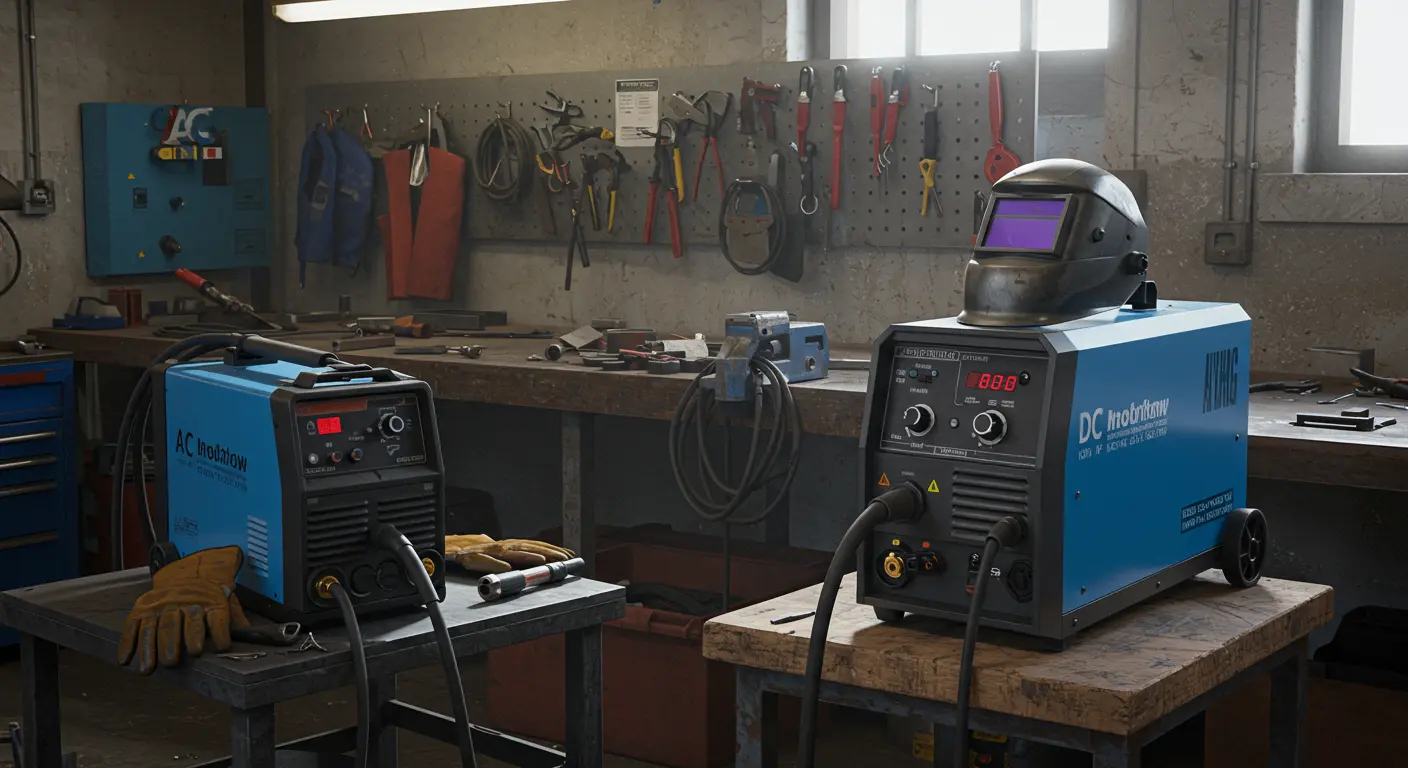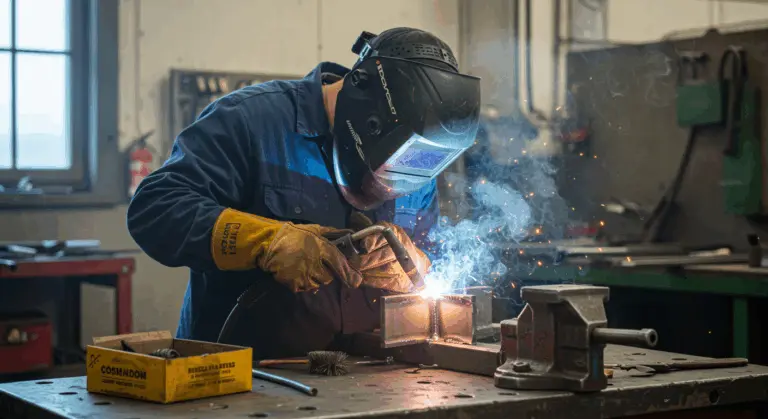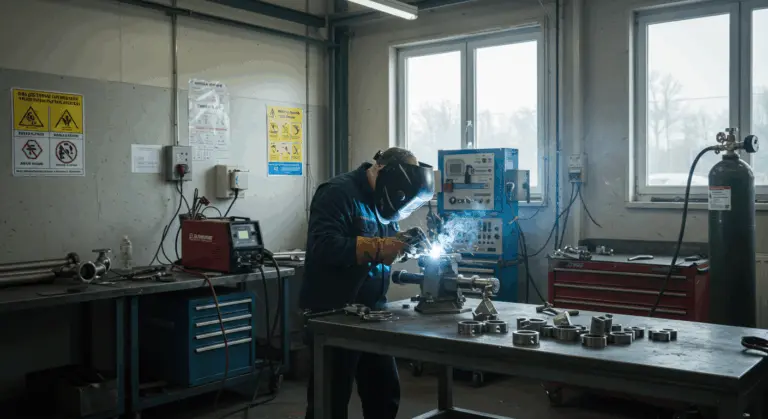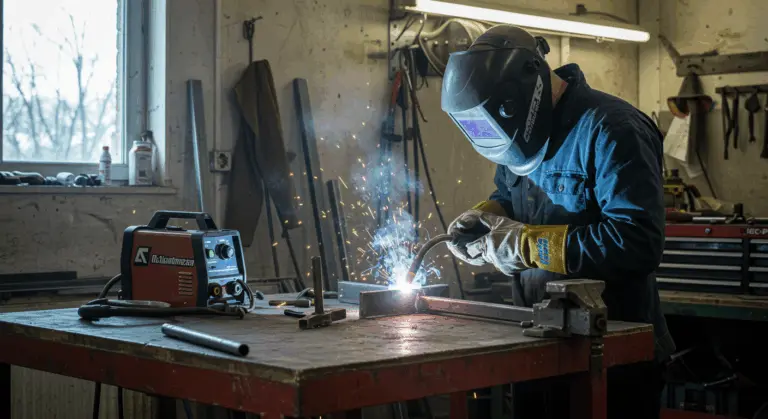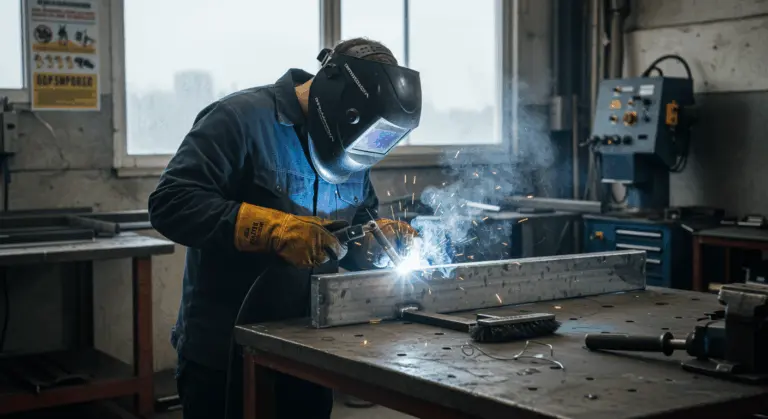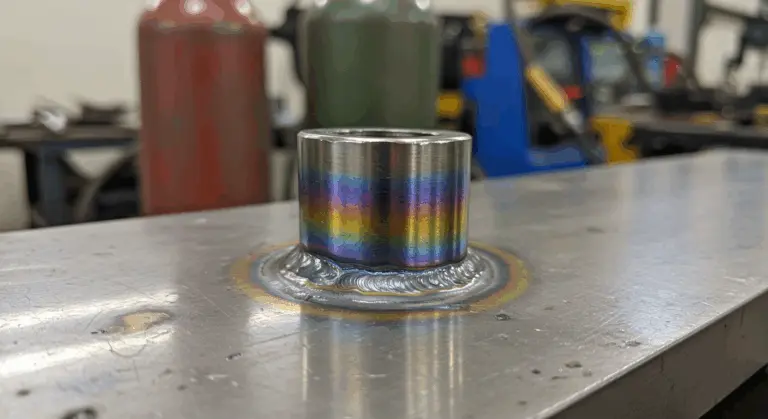Understanding AC and DC Welding – Key Differences
The choice between AC (alternating current) and DC (direct current) represents a fundamental decision in welding. Each power source delivers distinct arc characteristics that directly affect weld quality, suitable applications, and the overall welding experience.
AC welding offers cost-effectiveness and effectively reduces arc blow. However, it comes with trade-offs: weaker welds, increased spatter, and a steeper learning curve for newcomers.
DC welding, in comparison, delivers superior strength and smoother finishes with minimal spatter. It’s particularly forgiving when working with thin materials, though this performance comes at the cost of heavier, more expensive equipment.
AC Welding – How It Works
AC welding uses electrical current that reverses direction continuously—typically 60 times per second at 60Hz. This constant alternation generates an arc with fluctuating intensity that creates unique welding characteristics.
This dynamic behavior becomes essential when welding magnetic materials, as the alternating nature stabilizes the arc where DC might struggle with deflection.
Beyond arc stability, AC’s alternating current effectively removes oxides from work surfaces while distributing heat uniformly. This makes it particularly valuable for materials like aluminum, where stubborn oxide layers must be eliminated for quality welds.
-
TIG Welding Aluminum: The cleaning action is crucial for removing the surface oxide layer.
-
Welding Magnetized Metals: The alternating current resists magnetic arc blow.
-
Heavy Plate Welding: Ideal for downland welding with fast-fill electrodes.
-
Limited Power Access: Can be used with standard 110-volt electrical outlets.
DC Welding – How It Works
DC welding uses unidirectional current flow, creating a concentrated and remarkably stable heat source. This consistency translates directly into stronger, cleaner welds with superior control.
DC’s main advantage is its polarity flexibility: electrode positive (DEEP) drives deeper penetration into thick materials, while electrode negative (DEN) accelerates deposition rates for faster coverage.
DC welding’s stable arc produces minimal spatter and exceptionally smooth welds. It works particularly well on thick materials, yet its precision also makes it ideal for delicate thin metals. This versatility extends to challenging positions—overhead and vertical welding become significantly more manageable.
Advantages and Disadvantages of AC Welding
-
Budget-Friendly: AC machines are typically less expensive, making professional welding accessible to hobbyists and small operations.
-
Reduces Arc Blow: The alternating current creates a stable arc when welding magnetic materials.
-
Effective on Aluminum: The current’s cleaning action removes the tough surface oxide layer.
-
Energy Efficient: Requires less power to operate for many common applications.
-
Increased Spatter Production: The current’s fluctuating nature generates considerably more spatter, requiring thorough post-weld cleanup.
-
Lower Weld Quality: Welds are generally not as smooth or aesthetically pleasing as those from DC.
-
Steeper Learning Curve: Arc instability makes control challenging, especially challenging for newcomers to welding.
-
Limited Performance: Less effective for high-precision work and consumes smaller electrodes more quickly.
Advantages and Disadvantages of DC Welding
-
Superior Weld Quality: Delivers exceptionally smooth, clean weld beads with minimal spatter—significantly reducing post-weld finishing work.
-
Stable Arc: Direct current ignites reliably and maintains consistency, greatly enhancing operator control.
-
Versatile Performance: Excellent for steel and other ferrous metals, with great penetration for thick materials.
-
Polarity Options: DEN offers faster deposition for thin metals, while DEEP provides deeper penetration.
-
Positional Welding: The stable arc is ideal for challenging overhead and vertical positions.
-
Susceptible to Arc Blow: Struggles against magnetic arc blow, often requiring additional techniques or equipment to manage.
-
More Expensive: Internal transformers and rectifiers increase both initial cost and mechanical complexity.
-
Heavier Equipment: Tends to be less portable, making it inconvenient for field work.
-
Steeper Learning Curve: Requires more expertise to control effectively in some applications.
Choosing Between AC and DC Welding
Industry applications often dictate the optimal choice. Shipbuilding relies heavily on AC for robust seam welds and rapid fill passes on heavy plates. Generally speaking: choose AC for stick welding aluminum and magnetized steel—for most other applications, DC works better.
Applications of AC Welding
AC welding dominates aluminum applications, where its alternating current consistently removes the tenacious oxide layer that naturally forms on aluminum’s surface.
Shipbuilding operations favor AC for creating robust seam welds on thick plates. The alternating current allows higher amperage settings than DC equivalents, enabling faster completion of heavy structural joints.
When repairing magnetized machinery, AC becomes indispensable. Its alternating nature effectively neutralizes the magnetic arc blow that can make DC welding nearly impossible on such materials.
The combination of lower equipment costs and compatibility with standard household outlets makes AC welding equipment particularly attractive for small shops, hobbyists, and educational institutions operating on tight budgets.
Applications of DC Welding
DC welding is preferred for precision applications where appearance matters most—automotive bodywork and thin metal joining where minimal distortion is crucial.
The majority of Stick welding (SAW) applications rely on DC for its superior penetration, excellent arc stability, and minimal spatter. These characteristics ensure consistent, reliable results even in demanding overhead and vertical positions.
TIG welding of steels—whether mild, stainless, or carbon grades—works exceptionally well with DC’s precision. It delivers exceptional weld quality while maintaining low heat input, preserving the base material’s metallurgical properties.
Heavy fabrication and structural applications demand DC’s superior penetration capabilities. It creates very strong joints in thick materials while producing welds that require minimal post-weld cleanup—a significant advantage in production environments.
Conclusion – AC vs DC Welding Summary
AC welding works best for magnetized components and aluminum work, where its alternating current effectively minimizes arc blow while consistently removing troublesome surface oxides.
The trade-off? Increased spatter and less refined weld appearance. Yet AC’s primary advantages—economical equipment and enhanced portability—make it invaluable for specific applications.
DC welding delivers unmatched arc stability with minimal spatter, producing consistently smooth, high-quality welds that excel in steel applications and precision work.
Though DC equipment commands a higher price, its superior performance typically justifies the investment for professional applications. Understanding these fundamental differences helps welders make informed current selections, optimizing both efficiency and quality for each unique welding challenge.

